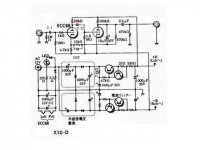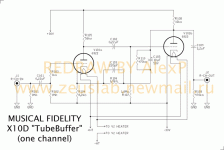I've been reading few posts on this forum about low voltage tubes. Mostly everyone here says they don't work well.
The reason I ask is that buddy lent me his Musical Fidelity X-10D to have a look and listen. I was very much surprised to see that it runs on 12 VAC!
Having never seen a tube run so low, I was curious how this thing could work.
The X-10 is a line stage, said to work in pure class-A. M.F. sold a lot of them and they got rave reviews. The thing doesn't have any gain, and seems to have almost no sonic signature. It's supposed to work well between a CD player and amp, like any line stage.
The 12V thing baffles me. Even my old Neuman and Schoeps mics with their tiny tubes used an external 90V supply.
Most of the advice on this forum is that low voltages can work, but never very well. Any comments? I can post a schematic if need be.
The reason I ask is that buddy lent me his Musical Fidelity X-10D to have a look and listen. I was very much surprised to see that it runs on 12 VAC!
Having never seen a tube run so low, I was curious how this thing could work.
The X-10 is a line stage, said to work in pure class-A. M.F. sold a lot of them and they got rave reviews. The thing doesn't have any gain, and seems to have almost no sonic signature. It's supposed to work well between a CD player and amp, like any line stage.
The 12V thing baffles me. Even my old Neuman and Schoeps mics with their tiny tubes used an external 90V supply.
Most of the advice on this forum is that low voltages can work, but never very well. Any comments? I can post a schematic if need be.
Indeed the X10-D works remarkably well (I had one for years and I loved it). I think the point most people would make is that the ECC88 can sound even better if supplied with about 100V. If diy'ing, why force a tube to the least of its abilities.
Far from the x10d having no sonic signture - I found it filled out the sound and extended the top end a little.
Shoog
Far from the x10d having no sonic signture - I found it filled out the sound and extended the top end a little.
Shoog
There are plenty of low-voltage tube designs around, and also plenty of tubes designed for low-voltage operation. A good example is the headphone amplifier by pete millet (www.diyforums.org) and a lot of the designs discussed in the headwize diy-forum (www.headwize.com). Still, I'd be very interested in the MF-schematic if you have it. If you can't post it here, you can email it to mepanomaniac said:Most of the advice on this forum is that low voltages can work, but never very well. Any comments? I can post a schematic if need be.
/U.
jaudio said:I believe the voltage is multiple after rectification
Yes, to +/-30V DC.
panomaniac said:I've been reading few posts on this forum about low voltage tubes. Mostly everyone here says they don't work well.
The reason I ask is that buddy lent me his Musical Fidelity X-10D to have a look and listen. I was very much surprised to see that it runs on 12 VAC!
Does the 12V AC come from a wall wart? If it's still AC, they could run it into the secondary of a 12V transformer and get 120VAC to rectify for some real B+ voltage. It wouldn't need to be that big; a transformer like those used in digital clock radios would be adequate.
Many manufactureres use wall warts to avoid the hassle of getting test lab approvals (like UL or the various European test labs).
Hey Tyimo,
Yes, I have that schematic too. It's good. A few of the values are different. But not much.
The 12V does come from outside, I just used a 12V 1A transfo that was handy. There is no transformer onboard, it is all stepped up via doubling (guess).
The big caps are at only rated at 35V, not much margin there. I'll try to get a value on all the componants and some voltages around the board.
Yes, I have that schematic too. It's good. A few of the values are different. But not much.
The 12V does come from outside, I just used a 12V 1A transfo that was handy. There is no transformer onboard, it is all stepped up via doubling (guess).
The big caps are at only rated at 35V, not much margin there. I'll try to get a value on all the componants and some voltages around the board.
Despite my admiration for the X10D, I would still say that a little judicious searching on the net will produce a much superior buffer circuit which should cost no more to build.
I found when I swapped in some NOS mullard ECC88 valves, the sound was very tubby. This leads me to suspect that the valves supplied with the X10D were used to tune the circuit for its neutral sound and you might not get the same result with other NOS tubes. By the way the valves in the X10D were not labelled so god knows where they were sourced from.
Shoog
I found when I swapped in some NOS mullard ECC88 valves, the sound was very tubby. This leads me to suspect that the valves supplied with the X10D were used to tune the circuit for its neutral sound and you might not get the same result with other NOS tubes. By the way the valves in the X10D were not labelled so god knows where they were sourced from.
Shoog
Hi
There are two voltage doublers on the output from the wal wart.
One gives approx +24 volts, and the other -24 volts, so the tube has 48 volts to play with effectively.
The 35 volt caps are ok, as this gives a margin of nearly 50%, which is pretty good.
Hope that this helps.
Kind regards
There are two voltage doublers on the output from the wal wart.
One gives approx +24 volts, and the other -24 volts, so the tube has 48 volts to play with effectively.
The 35 volt caps are ok, as this gives a margin of nearly 50%, which is pretty good.
Hope that this helps.
Kind regards
Hi,
Here is another version of the schematics (signal section only). It gives the same values as the previous one, except for C101, C103, R104 and R108. I guess someone will have to check on the actual PCB which is very readable.
I can't comment on the quality of this design but I must say that the quality of the parts leaves to desire... you find in there cheap caps, resistors and rectifiers and with a little work you replace these (as well as the wall plug) and enjoy a much more define and dynamic sound. At least, it's what I've done with the MF XPRE which is an equivallent in terms of design and now it sings!
See you
Here is another version of the schematics (signal section only). It gives the same values as the previous one, except for C101, C103, R104 and R108. I guess someone will have to check on the actual PCB which is very readable.
I can't comment on the quality of this design but I must say that the quality of the parts leaves to desire... you find in there cheap caps, resistors and rectifiers and with a little work you replace these (as well as the wall plug) and enjoy a much more define and dynamic sound. At least, it's what I've done with the MF XPRE which is an equivallent in terms of design and now it sings!
See you
Attachments
Shoog,
Could you suggest one? Until now what I find was all "worse"
than X10D. I mean they give very little "tube sound" and resolutions, dynamic etc.
Tyimo
Despite my admiration for the X10D, I would still say that a little judicious searching on the net will produce a much superior buffer circuit which should cost no more to build.
Could you suggest one? Until now what I find was all "worse"
than X10D. I mean they give very little "tube sound" and resolutions, dynamic etc.
Tyimo
Why so low voltage ? Distortion is not problem ? Or do you like it ?
"ECC88 at 12 volts" belongs rather to the digital section than to tubes. The only justification for such an aberation are cheap and nasty digital sources. Would anyone with a turntable consider listening through this?
- Status
- This old topic is closed. If you want to reopen this topic, contact a moderator using the "Report Post" button.
- Home
- Amplifiers
- Tubes / Valves
- ECC88 at 12 volts


